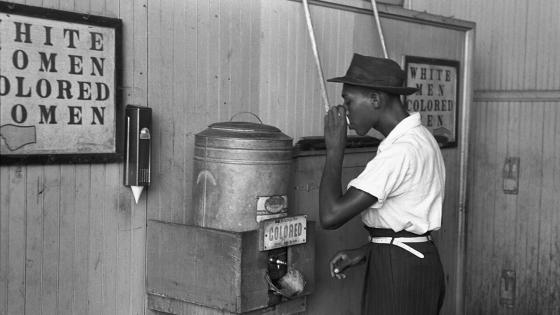In March 2010 President Obama presented the US Congress a plan to reform No Child Left Behind (NCLB), America’s main federal education programme. NCLB was enacted in 2002 under President Bush with the full bipartisan support of Congress. Yet one of the criticisms to NCLB stresses its failure to reduce the deeply rooted racial and ethnic gaps that still afflict the US education system.
There is a deep and wide literature on the educational divide in the US (see for example Smith 1984, Margo 1990, and Heckman and LaFontaine 2008). Even though slavery was eradicated almost a century and a half ago, the effort to assess how its legacy has affected educational inequality has been at the heart of these investigations. Indeed, not only did slavery play an important role in Africa’s underdevelopment (Nunn 2007), but also in the US where, by the time slavery was abolished with the Civil War, African-Americans former slaves had essentially no exposure to formal schooling.
The first generations of their descendants were only able to complete far fewer years of schooling, on average, than whites. Moreover, they had access to racially segregated public schools, mostly in the South, where they received a qualitatively inferior education, even if compared to that received by southern whites. The combination of low educational attainment and inferior educational quality led to the persistence of large wage and income gaps. Subsequently, as successive generations of black children received more and better schooling, the racial schooling gap declined, with an eventual impact on earnings. Overall, the reported evidence on the evolution of educational differences, in a wide number of dimensions (literacy rates, years of educational attainment, spending per pupil, and returns to literacy), overwhelmingly points to long-term convergence, even though the gaps are far come closed.
Beside human capital accumulation, the general improvement of the general economic status of blacks may also have been achieved through other factors, such as migration out of the rural South to the urban North and the removal of discrimination thanks to the civil rights movement (Heckman 1990). The legacy of slavery has also been studied within the literature on growth and institutions (Engerman and Sokoloff 2005, Acemoglu and Robinson 2008, and Nunn 2008), which has developed and tested, with mixed results, the hypothesis that specific factor endowments may have favoured the diffusion of large-plantation slavery, an inequality-perpetuating institution with negative implications for subsequent economic growth.
The effects of slavery today
Whether slavery still affects the US economy and society, and in what dimensions, remains an open question, and one which we address in a recent paper (Bertocchi and Dimico 2010). Within the US, the institution of slavery has historically been associated more heavily with specific areas – primarily the South. This geographic differentiation allows us to identify the link between past slavery and current outcomes. We start by reviewing, over a cross section of counties, the effect of the intensity of slavery in 1870 on the current level of income per capita. For the year 2000, we find no evidence that those counties that employed slave labour more heavily are poorer than those that did so to a lesser extent or not at all (even though a negative relationship between slavery and income was still present until 1970).
Next we turn to the impact of slavery on current income disparities and we find that it is indeed associated with a higher degree of income inequality. In other words, former slave counties are more unequal in the present day. They also show a higher poverty rate and a higher degree of racial inequality. Moreover, the data say that the impact of slavery on economic inequality and poverty runs through its impact on racial inequality, and not vice versa.
Minds enslaved
In order to understand the channel through which racial inequality, as caused by slavery, affects current income distribution, we test three alternative theories:
- a land inequality theory,
- a racial discrimination theory,
- and a human capital transmission theory.
According to the first, slavery would affect current performances through its link with factor endowments, which in our context can be measured by land inequality. According to the second, slavery would be responsible for inducing racial discrimination and an implied racial wage gap, which can be measured by the gap in the returns on education for blacks and whites. According to the third, the long-term influence of slavery may run through its negative impact on human capital accumulation for blacks, i.e., through a persistent racial gap in education.
Even though the three theories are not necessarily mutually exclusive (Galor et al., 2009, for instance, look at the link between land inequality and education), the data support the third one. In fact, we do find a positive effect on current income inequality and poverty both for land inequality and for racial discrimination but, after controlling for these factors, the impact of slavery is hardly diminished, which suggests that they do not represent the channel through which slavery still manifests its role. However, when we control for the racial gap in education, slavery does lose its explanatory power. In other words, our analysis identifies in racial educational inequality the channel through which slavery still exerts its legacy.
To improve our understanding of the dynamics of racial inequality along the educational dimension, we complete our investigation by analysing a panel dataset covering the 1940-2000 period at the state level. We find that the racial educational gap significantly depends on the initial gap, which is in turn highly correlated with the intensity of slavery in 1860.
Lingering inequality
Even in rich countries, inequality remains a persistent problem. Many forms of inequality are inherited from the past, and yet they continue to grow. We have shown that within the US slavery does exert a lingering effect on income disparities and that it works through the persistent racial gap in education. This confirms how educational inequality is deeply-rooted in the history of the US. Since other forms of coercive labour, such as serfdom, have also characterised other countries besides the US, our findings can also be extended in comparative perspective in order to ascertain if the characteristics and the timing of labour coercion matter for subsequent developments.
References
Acemoglu, D and JA Robinson (2008), “Persistence of Power, Elites, and Institutions”, American Economic Review, 98:267-293.
Bertocchi, G, and A Dimico (2010), “Slavery, Education, and Inequality”, CEPR Discussion Paper 8073.
Engerman, SL and KL Sokoloff (2005), “Institutional and Non-institutionals Explanations of Economic Differences”, in C Menard and MM Shirley (eds.), Handbook of New Institutional Economics, Springer, Dordrecht, 639-665.
Galor, O, O Moav, and D Vollrath (2009), “Inequality in Landownership, the Emergence of Human-Capital Promoting Institutions, and the Great Divergence”, Review of Economic Studies, 76:143-179.
Heckman, JJ and Paul A LaFontaine (2008), “The declining American high school graduation rate: Evidence, sources, and consequences”, VoxEU.org, 13 Feburary.
Heckman, JJ (1990), “The Central Role of the South in Accounting for Economic Progress of Black Americans”, American Economic Review, 80:242-246.
Margo, RA (1990), Race and Schooling in the South, 1880-1950: An Economic History, University of Chicago Press.
Nunn, N (2007), “The historical origins of Africa’s underdevelopment”, VoxEU.org, 8 December.
Nunn, N (2008), “Slavery, Inequality, and Economic Development in the Americas: An Examination of the Engerman-Sokoloff Hypothesis”, in E Helpman (ed.), Institutions and Economic Performance, Harvard University Press: 48-180.
Smith, JP (1984), “Race and Human Capital”, American Economic Review, 74:685-98.


